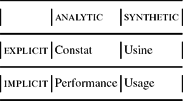Article contents
Transcendental syntax I: deterministic case
Published online by Cambridge University Press: 20 July 2015
Abstract
We study logic in the light of the Kantian distinction between analytic (untyped, meaningless, locative) answers and synthetic (typed, meaningful, spiritual) questions. Which is specially relevant to proof-theory: in a proof-net, the upper part is locative, whereas the lower part is spiritual: a posteriori (explicit) as far as correctness is concerned, a priori (implicit) for questions dealing with consequence, typically cut-elimination. The divides locative/spiritual and explicit/implicit give rise to four blocks which are enough to explain the whole logical activity.
- Type
- Paper
- Information
- Copyright
- Copyright © Cambridge University Press 2015
References
- 2
- Cited by





